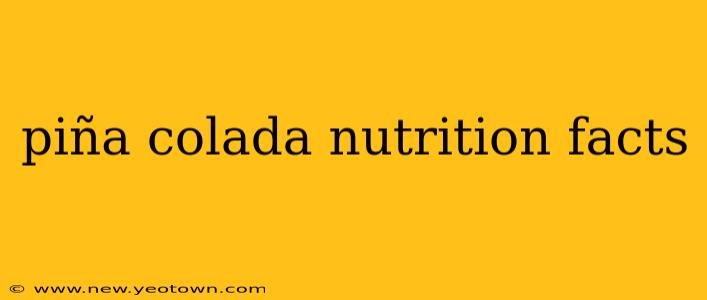Ah, the piña colada—the quintessential tropical cocktail, conjuring images of sun-drenched beaches and gentle ocean breezes. But beyond its delicious taste and evocative imagery, what's the nutritional profile of this creamy coconut delight? Let's dive into the details and uncover the truth behind the piña colada's nutritional facts.
This isn't your average smoothie; the classic piña colada packs a punch, and its nutritional content can vary wildly depending on the recipe and ingredients used. A typical version, however, will include a healthy dose of calories, primarily from the alcohol, coconut cream, and pineapple juice.
Understanding the Calorie Count
How many calories are in a piña colada? This is a common question, and the answer isn't a simple number. A standard piña colada, made with about 4 ounces of white rum, 4 ounces of pineapple juice, and 2 ounces of cream of coconut, can contain anywhere from 250 to 400 calories. However, variations using light rum, less cream of coconut, or even coconut milk instead can significantly reduce the calorie count. Frozen versions, often packed with ice and blended to a slushy consistency, can also lower the overall calorie density, though this is generally a matter of dilution rather than reducing the inherent calories of the ingredients.
What are the main ingredients and their nutritional impact?
The main components of a piña colada, pineapple juice, rum, and coconut cream, all contribute to the nutritional makeup.
- Pineapple Juice: Provides Vitamin C, manganese, and some dietary fiber, offering a touch of sweetness and a refreshing tropical flavor. However, the sugar content in pineapple juice is considerable.
- Rum: Primarily contributes calories from alcohol, offering minimal nutritional value beyond those calories. Different types of rum, such as white rum versus dark rum, may have slight variations in their composition.
- Coconut Cream: A significant source of saturated fat and calories. It also offers some healthy fats and trace minerals, but it’s best enjoyed in moderation.
Is a piña colada healthy?
Is a piña colada healthy? The short answer is: not particularly. While it contains some vitamins and minerals from the pineapple juice, the high sugar and saturated fat content, along with the alcohol, means it shouldn't be considered a health food. Enjoy it occasionally as a treat, rather than a regular part of a balanced diet.
What are the benefits of drinking a piña colada? (If any)
What are the benefits of drinking a piña colada? Honestly, the primary benefit is the enjoyment and the sensory experience. The refreshing taste and association with relaxation and vacation can be mood-boosting. The small amount of Vitamin C from the pineapple juice is a minor benefit, but it's easily outweighed by the other ingredients' impact.
What are the potential downsides of drinking a piña colada?
What are the potential downsides of drinking a piña colada? The high sugar and saturated fat content contribute to potential weight gain. The alcohol content can lead to impaired judgment and potentially harmful effects, especially if consumed in excess. Individuals with specific dietary restrictions or health concerns, such as those managing blood sugar levels or high cholesterol, should consume them very sparingly, if at all.
Are there any healthier alternatives to a traditional piña colada?
Are there any healthier alternatives to a traditional piña colada? Absolutely! Consider these options:
- Reduced-sugar version: Use less pineapple juice and/or a sugar substitute, reducing the sugar load.
- Light rum: Opt for a lighter rum to decrease the calorie and alcohol content.
- Coconut milk instead of cream: Coconut milk is a lower-calorie option that still offers the creamy texture and coconut flavor.
- Virgin Piña Colada: Skip the rum entirely for a completely alcohol-free, lower-calorie option.
Ultimately, the piña colada is a delicious treat best enjoyed in moderation. Understanding its nutritional profile empowers you to make informed choices and enjoy this tropical classic responsibly. Remember to always drink responsibly and in moderation.

